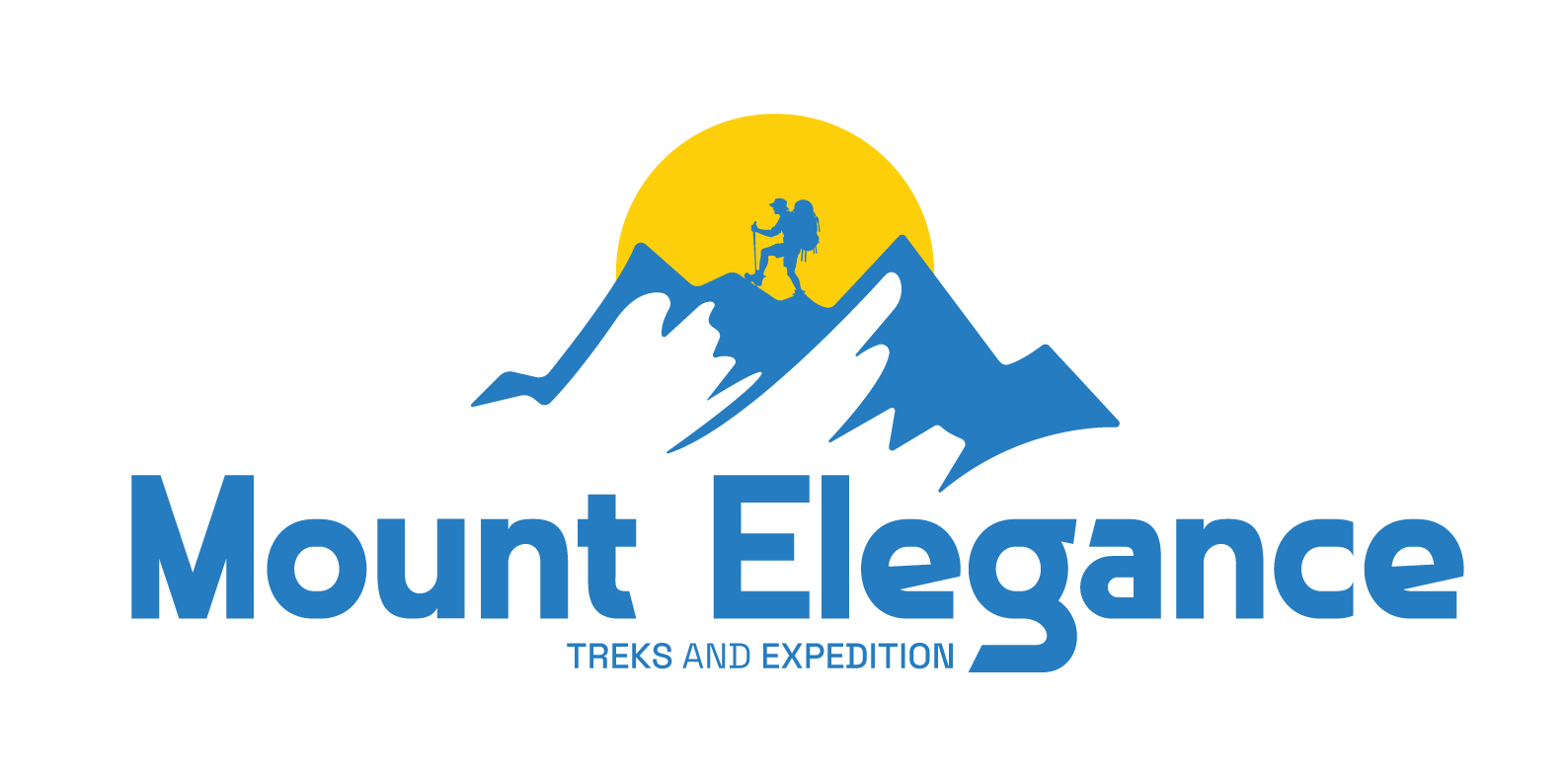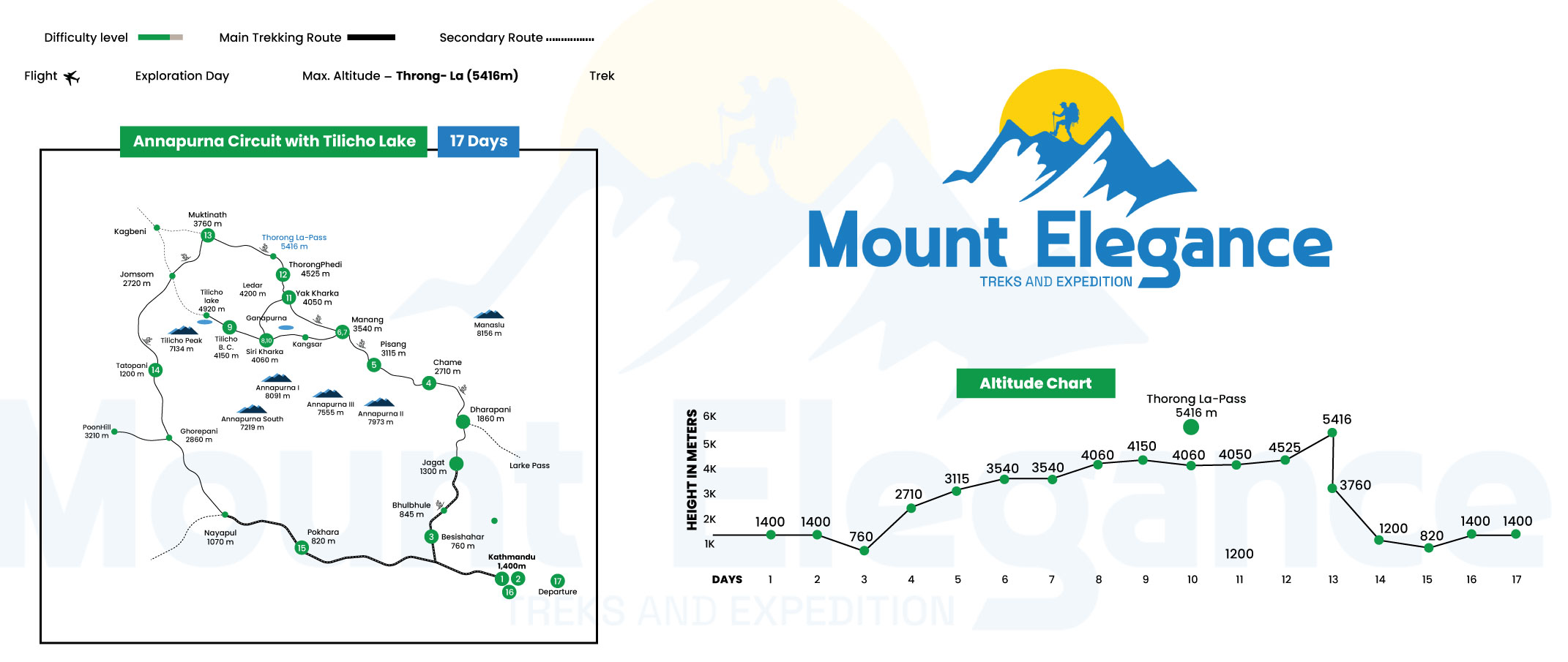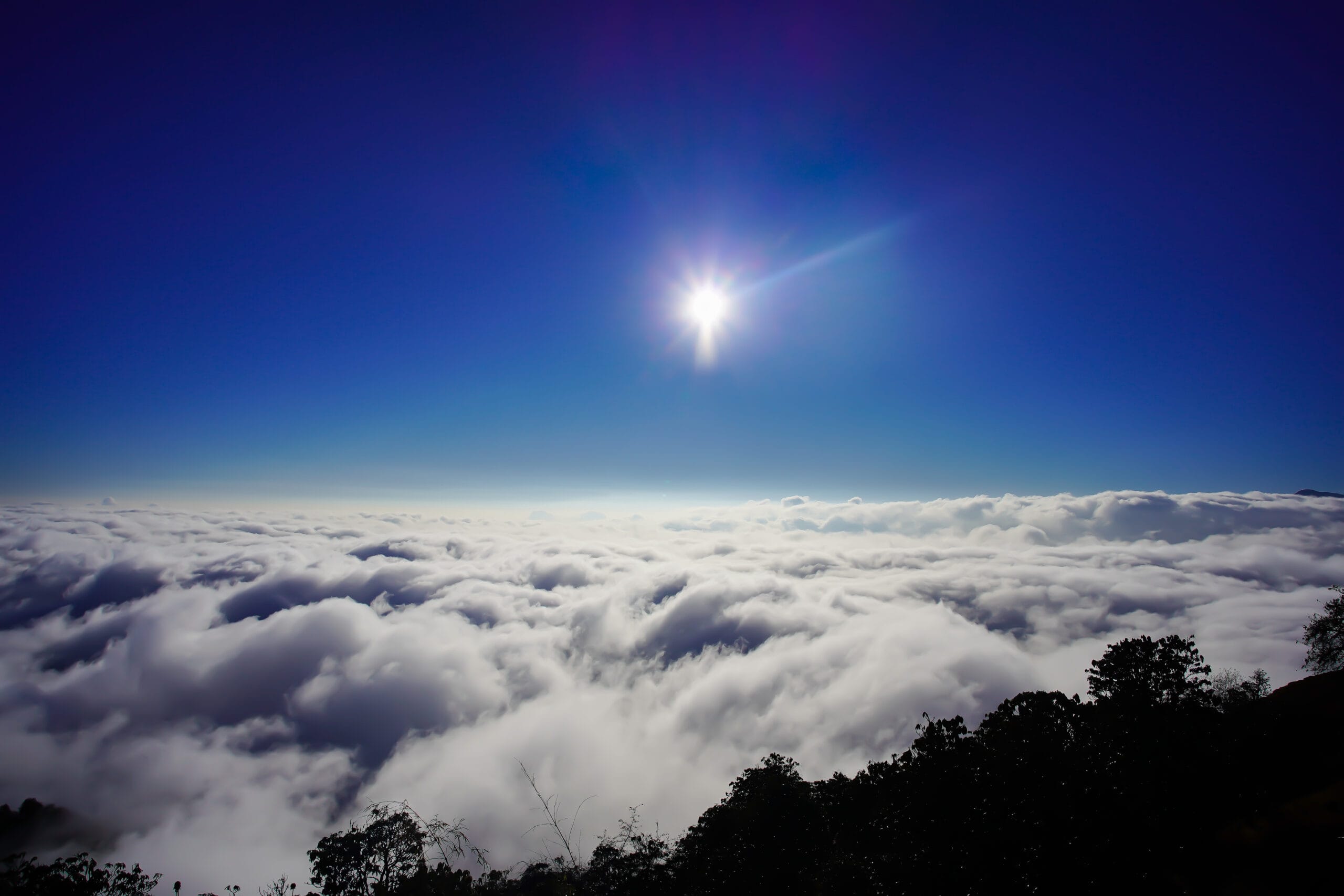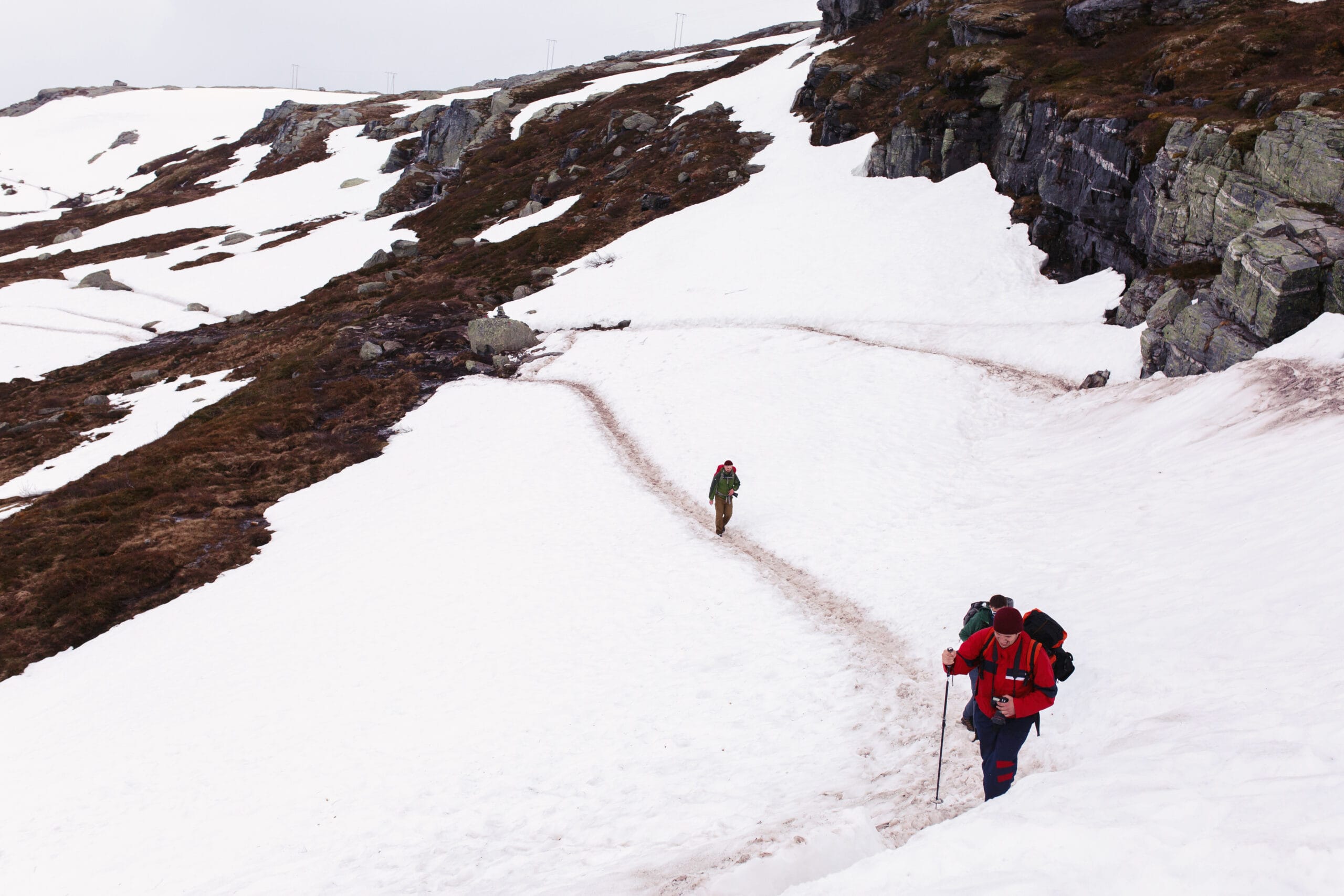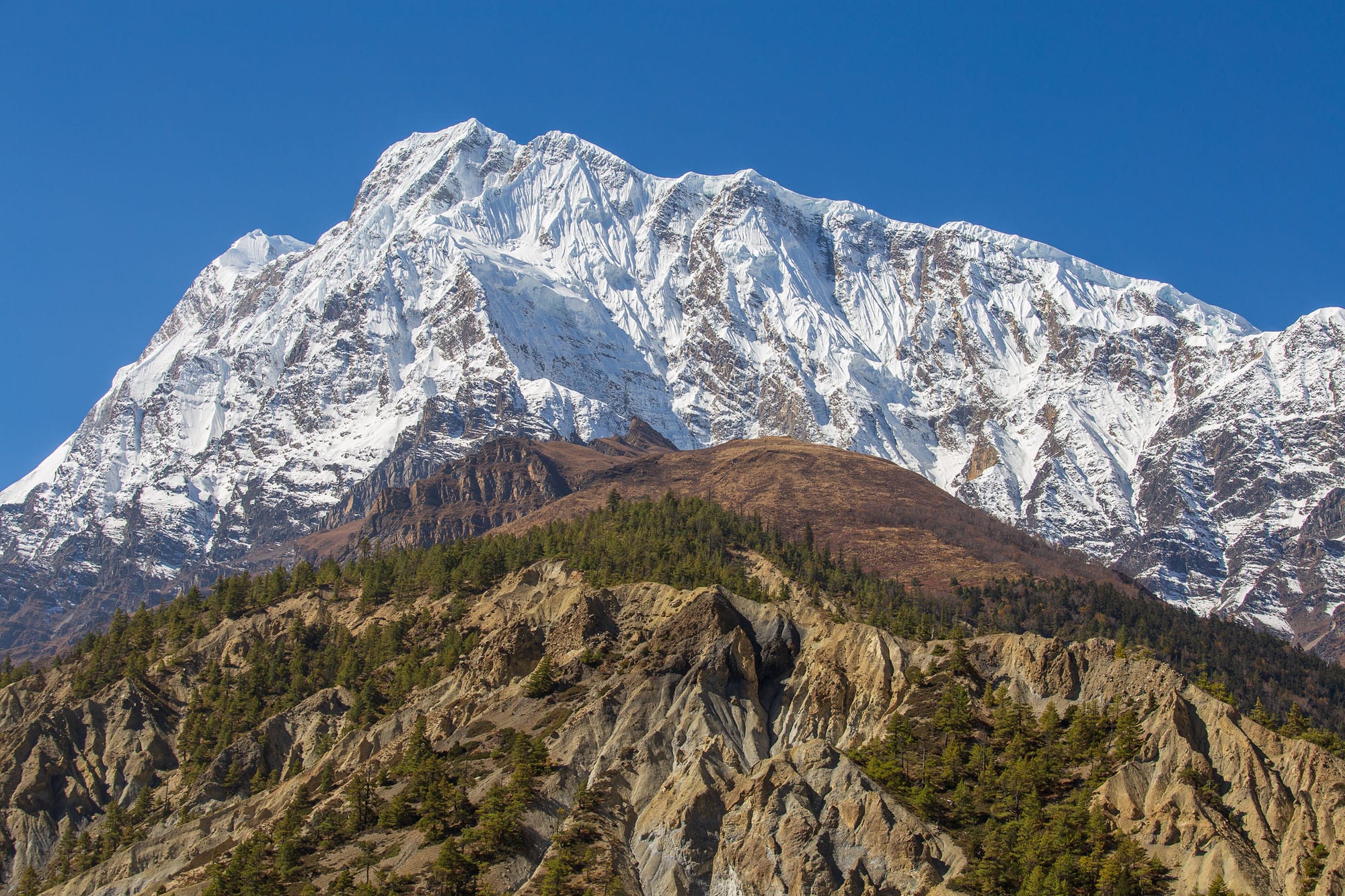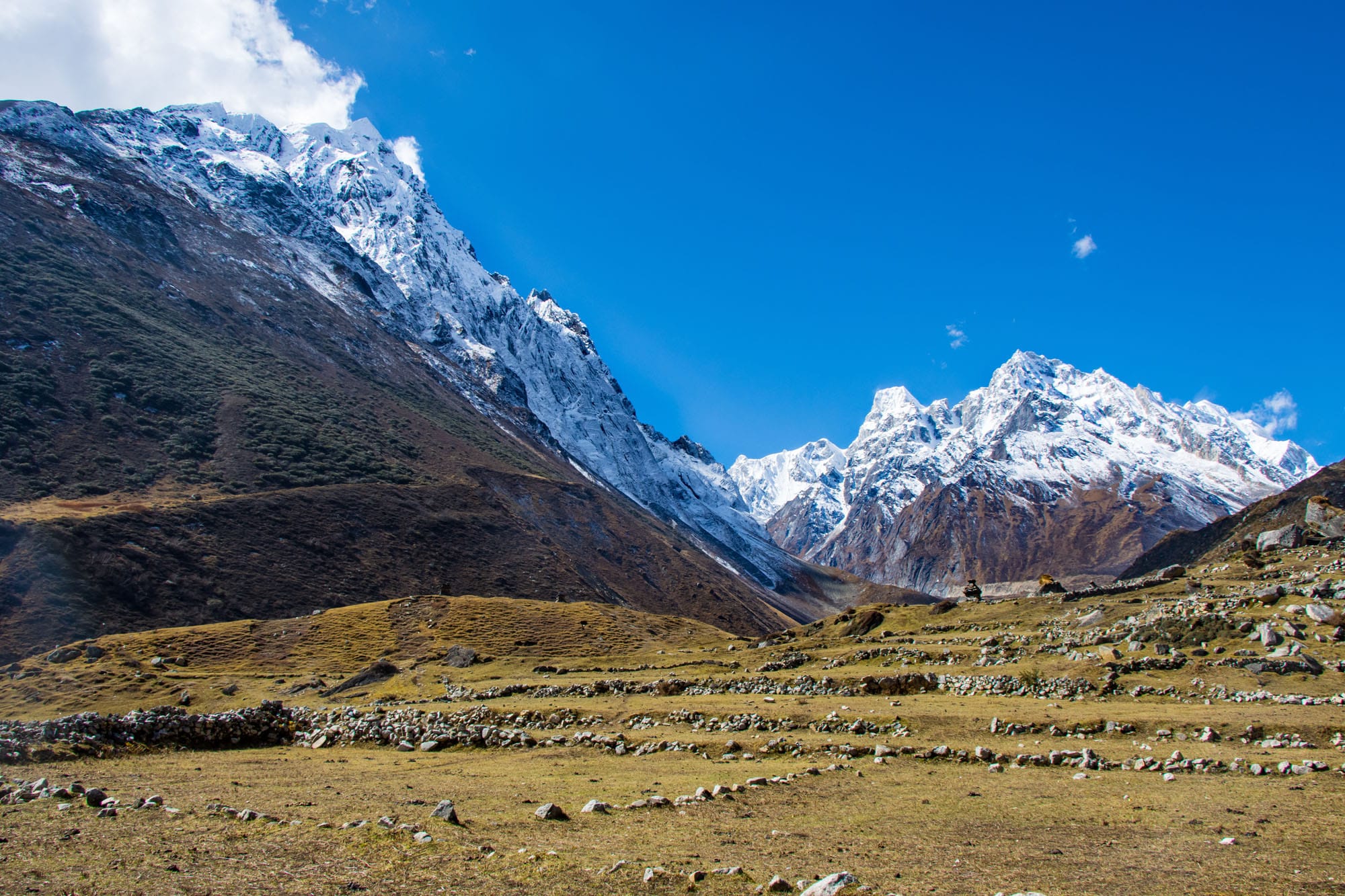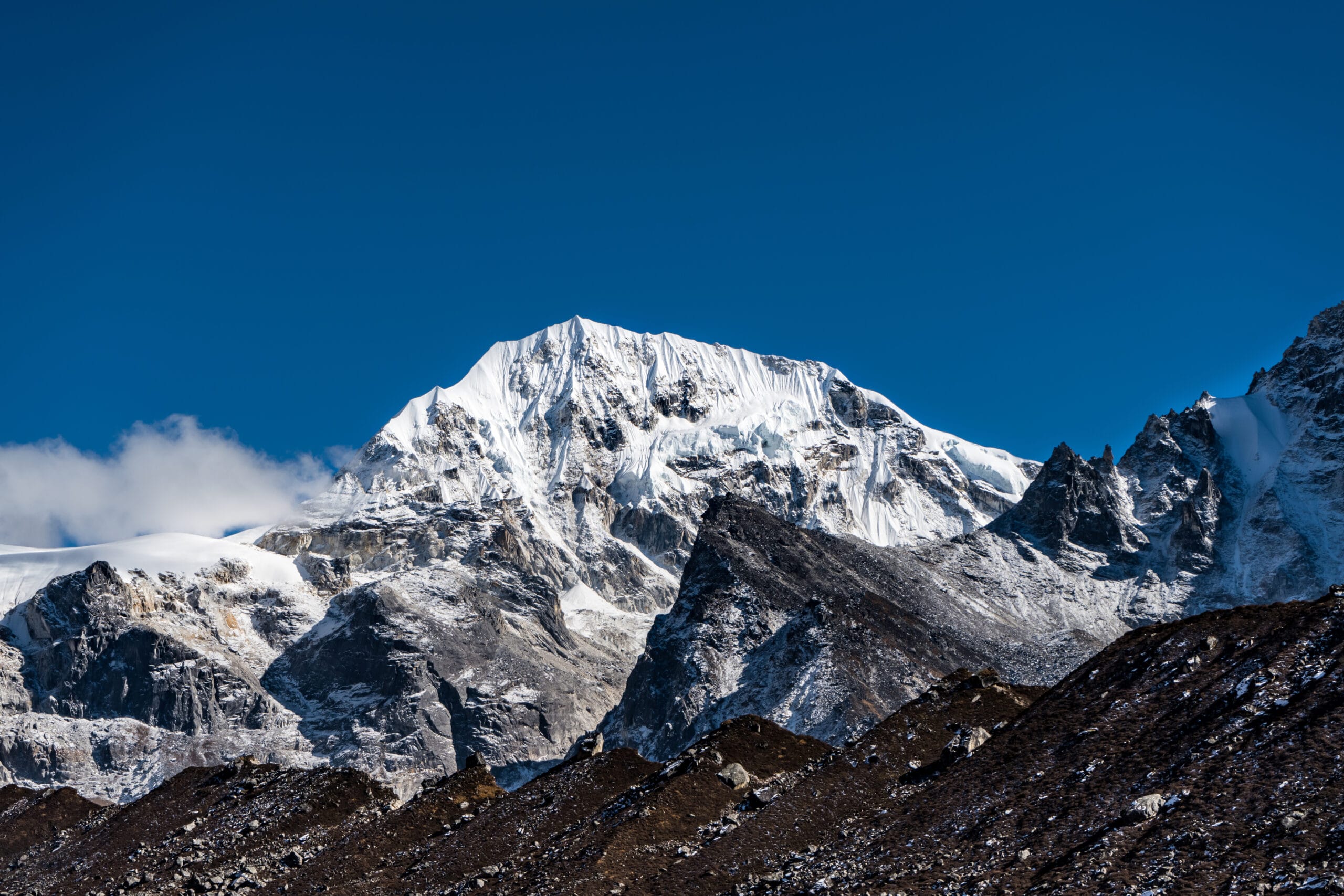Annapurna Circuit with Tilicho Lake -17 D
Best Season
Highest Altitude
Trip Overview
The Annapurna Circuit Trek with Tilicho Lake is one of Nepal’s most captivating and diverse trekking experiences. To begin with, it offers trekkers an incredible blend of lush valleys, alpine forests, arid highlands, and traditional Himalayan villages. As you gradually ascend from subtropical hills to dramatic mountain landscapes, you’ll not only witness jaw-dropping scenery but also experience the rich cultural heritage of Gurung, Manangi, and Thakali communities. As the Annapurna Circuit Trek with Tilicho Lake is a legendary Himalayan adventure that seamlessly combines natural grandeur with cultural richness which begins through terraced farmlands, dense pine forests, and river-carved gorges — all while gradually ascending to some of the most dramatic alpine landscapes in Nepal.
Cultural Immersion in Mountain
The Annapurna Circuit Trek is not just a scenic adventure—it’s also a rich cultural journey that offers an intimate glimpse into the diverse ethnic mosaic of the Himalayas. As you ascend from the lush lowlands of Lamjung to the arid trans-Himalayan region of Mustang, each day introduces you to unique communities, languages, rituals, and lifestyles.
Crossing the Majestic Thorong
Reaching the Thorong La Pass (5,416m) is the crown jewel of the Annapurna Circuit—a day of anticipation, grit, and unmatched reward. As one of the highest trekking passes in the world, this crossing is both a physical challenge and a spiritual triumph, offering a surreal experience in the heart of the Himalayas.
Conclusion: A Trek for All Adventurers
The Annapurna Circuit with Tilicho Lake is more than just a trek—it’s a life-changing expedition that offers something for every kind of adventurer. Whether you’re drawn by the natural grandeur of the Himalayas, the cultural richness of remote mountain communities, or the thrill of high-altitude exploration, this journey delivers it all.
Trip Highlights of Annapurna Circuit Trek with Tilicho Lake
- Traverse a variety of landscapes, from subtropical forests to alpine meadows and high Himalayan deserts.
- Visit Tilicho Lake (4,919m) – the world’s highest glacial lake, surrounded by dramatic snow peaks.
- Cross the iconic Thorong La Pass (5,416m), one of the highest and most scenic trekking passes on earth.
- Explore the culturally rich villages of Manang, Pisang, and Kagbeni with Tibetan Buddhist influences.
- Discover the sacred Muktinath Temple, a spiritual site for both Hindus and Buddhists.
- Enjoy spectacular views of major peaks: Annapurna I-IV, Dhaulagiri, Tilicho Peak, Gangapurna, and Nilgiri.
Essential Items
- Base layers (thermal tops and bottoms)
- Insulated jacket (down or synthetic)
- Waterproof/windproof jacket and pants
- Fleece or mid-layer jacket
- Trekking pants (lightweight and warm)
- T-shirts (quick-dry)
- Warm hat/beanie
- Sun hat or cap
- Waterproof trekking boots (well broken-in)
- Camp shoes or sandals (for evening use)
- Gaiters (optional but useful in snow or mud)
Itinerary
Meals: Breakfast
Highest Altitude: 1,400m
Accommodation: Hotel in Kathmandu
Your adventure begins in Kathmandu, Nepal’s bustling capital city and the gateway to the Himalayas. Upon arrival at Tribhuvan International Airport, our representative will greet you and transfer you to your hotel in Thamel, the vibrant trekking hub of the city. This day is focused on relaxation after your journey and preparing for the Annapurna Circuit with Tilicho Lake trek.
In the evening, you’ll meet your trekking guide for a detailed briefing about the trail, safety measures, and altitude acclimatization. Over a welcome dinner, enjoy authentic Nepali cuisine while connecting with your trekking team. If time allows, you can explore Kathmandu’s lively streets filled with local shops, temples, and cafes.
Meals: Breakfast
Highest Altitude: 1,400m
Accommodation: Hotel in Kathmandu
Today is dedicated to exploration and cultural immersion in Kathmandu Valley. A guided sightseeing tour will take you to UNESCO World Heritage Sites, including the sacred Pashupatinath Temple, the iconic Swayambhunath Stupa (Monkey Temple), and the artistic Kathmandu Durbar Square. These sites give you a deep insight into Nepal’s spiritual and cultural richness before beginning the trek.
You’ll also have time to check your trekking gear and shop for any essentials in Thamel. In the evening, you can relax and prepare mentally for the long trek ahead. This day ensures you are well-acclimatized and fully ready for the Annapurna Circuit trek starting tomorrow.
Trek Duration: 7–8 hours (Drive)
Meals: Breakfast, Lunch, Dinner
Highest Altitude: 1,400m
Accommodation: Tea House/Lodge
After an early breakfast, you’ll set off on a scenic drive along the Prithvi Highway. The route follows the Trishuli and Marshyangdi rivers, passing through terraced farmlands, green hills, and traditional roadside settlements. This long drive offers glimpses of Nepal’s diverse landscapes, with snow-capped mountains visible in the distance on a clear day.
By afternoon, you’ll arrive in Besisahar, the official starting point of the Annapurna Circuit Trek. This bustling town serves as the gateway to the trek and offers your first introduction to the Annapurna region’s culture and mountain atmosphere. You’ll stay in a comfortable tea house before beginning the trek on foot tomorrow.
- Trek Duration: 6–7 hours
- Meals: Breakfast, Lunch, Dinner
- Highest Altitude: 2,710m
Leaving behind the subtropical valleys of Besisahar, the trail steadily climbs through lush forests and terraced fields. You’ll pass roaring rivers, suspension bridges, and small villages that gradually reveal more alpine landscapes. The cool mountain air becomes more noticeable as the altitude increases.
Arriving in Chame, the administrative center of the Manang district, trekkers are greeted with stunning views of Lamjung Himal and Annapurna II. The village has prayer wheels, mani walls, and hot springs, providing both cultural charm and physical relief after the day’s trek.
Trek Duration: 5–6 hours
Meals: Breakfast, Lunch, Dinner
Highest Altitude: 3,200m
The trek from Chame to Pisang follows a trail carved between steep rock faces and dense pine forests. The route gradually ascends, with the Marsyangdi River flowing alongside. Mani walls and fluttering prayer flags appear more frequently as you approach higher altitudes.
Pisang, a picturesque village split into Upper and Lower Pisang, offers breathtaking views of Annapurna II, Annapurna IV, and Pisang Peak. The wooden houses, traditional monasteries, and expansive valley landscapes highlight the cultural and natural richness of the region.
Trek Duration: 6–7 hours
Meals: Breakfast, Lunch, Dinner
Highest Altitude: 3,540m
From Pisang, the trail gradually opens into a wide valley with expansive landscapes. Trekkers can choose between the lower trail via Hongde or the more scenic upper route through Ghyaru and Ngawal. The upper route is highly recommended for its panoramic views of Annapurna II, III, IV, Tilicho, and Gangapurna. Prayer flags and stone chortens dot the path, giving the journey a spiritual touch.
As you approach Manang, the vegetation becomes sparse, and the arid, Tibetan-like terrain dominates. Manang is a cultural hub where trekkers acclimatize, enjoy the monastery visits, and explore traditional stone-built houses. The views of Gangapurna Glacier and Annapurna range from Manang are simply breathtaking.
Trek Duration: Short hikes around Manang (2–3 hours)
Meals: Breakfast, Lunch & Dinner
Accommodation: Tea House/Lodge
Today is a rest and acclimatization day in Manang, allowing trekkers to adjust to the higher altitude. Short hikes can be made to Gangapurna Lake or nearby viewpoints, offering breathtaking views of surrounding peaks while helping prevent altitude sickness. The lighter trekking schedule also provides time to relax and enjoy the serene village atmosphere.
Manang is a charming village with Tibetan-style stone houses, monasteries, and small local cafes. Trekkers can explore the local culture, interact with villagers, and enjoy panoramic mountain vistas, preparing both physically and mentally for the challenging trek ahead toward Tilicho Base Camp.
- Trek Duration: 4–5 hours
- Meals: Breakfast, Lunch, Dinner
- Highest Altitude: Sri Kharka (4,060 m / 13,320 ft)
- Accommodation: Tea House/Lodge
Depart Manang toward the Tilicho Lake side trail, passing through Khangsar village and ascending amid juniper scrub with views of Tilicho Peak. The path gains elevation steadily in a remote, rugged setting.
Sri Kharka features basic tea houses in a secluded valley, providing a sense of isolation and proximity to the high peaks for an overnight stay.
- Trek Duration: 5–6 hours
- Meals: Breakfast, Lunch, Dinner
- Highest Altitude: Tilicho Base Camp (4,150 m / 13,615 ft)
- Accommodation: Tea House/Lodge
Trek upward to Tilicho Base Camp, navigating steep sections and landslide-prone areas with caution. The landscape becomes more alpine, with potential sightings of blue sheep.
Base camp offers simple lodges surrounded by towering mountains, serving as a hub for lake explorers and a spot to rest before the highlight excursion.
- Trek Duration: 6–7 hours (round trip to lake and descent)
- Meals: Breakfast, Lunch, Dinner
- Highest Altitude: Tilicho Lake (4,919 m / 16,138 ft)
- Accommodation: Tea House/Lodge
Hike from base camp to the breathtaking Tilicho Lake, one of the highest in the world, for stunning turquoise waters and glacial views. Spend time exploring before descending back to Sri Kharka.
The return allows recovery from the high elevation, with reverse scenery enhancing the day's achievement in this pristine Himalayan corner.
- Trek Duration: 4–5 hours
- Meals: Breakfast, Lunch, Dinner
- Highest Altitude: Yak Kharka (4,050 m / 13,287 ft)
- Accommodation: Tea House/Lodge
Rejoin the main Annapurna Circuit trail, trekking through open meadows where yaks graze, with gradual ascents and valley views.
Yak Kharka provides scenic tea houses, ideal for acclimatization and preparation for the upcoming Thorong La Pass crossing.
- Trek Duration: 3–4 hours
- Meals: Breakfast, Lunch, Dinner
- Highest Altitude: Thorong Phedi (4,525 m / 14,846 ft)
- Accommodation: Tea House/Lodge
A short but ascending trek to Thorong Phedi, conserving energy amid stark, rocky terrain with glimpses of the pass ahead.
Base camp lodges here focus on rest, with early bedtimes recommended for the challenging day to follow.
- Trek Duration: 7–8 hours
- Meals: Breakfast, Lunch, Dinner
- Highest Altitude: Thorong La Pass (5,416 m / 17,769 ft)
- Accommodation: Tea House/Lodge
Cross the iconic Thorong La Pass with sweeping panoramas of the Annapurnas and Dhaulagiri ranges, then descend steeply into the Mustang district to Muktinath.
This sacred site features a temple complex blending Hindu and Buddhist elements; explore before settling into a lodge in the arid landscape.
- Drive Duration: 5–6 hours (jeep)
- Meals: Breakfast, Lunch, Dinner
- Highest Altitude: Muktinath (3,760 m / 12,336 ft)
- Accommodation: Guesthouse or lodge in Tatopani
Jeep down the Kali Gandaki Valley, passing windy Kagbeni, apple-famous Jomsom, and Marpha village, descending into warmer climes.
Tatopani, meaning "hot water," boasts natural hot springs for soothing soaks, with comfortable guesthouses to unwind.
- Drive Duration: 4–5 hours
- Meals: Breakfast & Lunch
- Highest Altitude: Tatopani (1,200 m / 3,937 ft)
- Accommodation: Hotel in Pokhara
Continue driving through the deepening gorge to Beni, then onward to the lakeside city of Pokhara, with views of rivers and foothills.
Pokhara offers relaxation by Phewa Lake, adventure options, and hotels with modern amenities to celebrate the trek's completion.
- Drive Duration: 6–7 hours
- Meals: Breakfast & Dinner
- Highest Altitude: Pokhara (820 m / 2,690 ft)
- Accommodation: Hotel in Kathmandu
Return to Kathmandu via the Prithvi Highway, reflecting on the journey amid scenic valleys and towns.
Back in the capital, enjoy free time for shopping or revisiting sites before a farewell dinner.
- Drive Duration: Airport transfer (30-60 minutes)
- Meals: Breakfast
- Highest Altitude: Kathmandu (1,400 m / 4,593 ft)
Transfer to the airport for your international flight, concluding the adventure with memories of Nepal's majestic landscapes and cultural richness.
If time allows, squeeze in last-minute explorations or souvenirs before departure.
Book Now
Send an Inquiry
Got A Question?

Mr. Shishir Dhakal
Price Inclusion
- Airport transfers in Kathmandu.
- Drive from Kathmandu- Besisahar- chame and Muktinath- Pokhara- Kathmandu by bus/Jeep.
- Accommodation in Kathmandu and Pokhara (3-star hotel) including breakfast.
- Accommodation in teahouses during the trek.
- All meals (breakfast, lunch, and dinner) during the trek.
- Experienced English-speaking trekking guide.
- Annapurna Conservation Area Permit (ACAP) and TIMS card.
- Seasonal fresh fruit as dessert every evening after dinner.
- Mount Elegance free Tshirt and Route map.
- Complimentary first aid box (Guide will carry during trekking).
- Oximeter to measure the Oxygen (For awareness of the high altitude sickness).
- Duffel bag and sleeping bag for trekking (Should be returned after trek completion).
- One porter for two trekkers.
- Farewell dinner at the end of the trek.
- Certificate after trek completion.
Price Exclusion
- International airfare to and from Kathmandu.
- Nepal entry visa fees.
- Personal trekking equipment and gear.
- Tips for guides and porters.
- Extra expenses such as bar bills, laundry, and telephone charges.
- Travel insurance for personal loss, injury, or illness.
Additional Information
Trip Map
Meals and Accommodation
Embarking on the Annapurna Circuit Trek offers not only breathtaking landscapes but also a chance to experience the warmth and hospitality of the Himalayan teahouse culture. Throughout the journey, trekkers stay in locally run teahouses and lodges, known for their cozy and welcoming atmosphere. Rooms are typically simple, with twin beds, mattresses, and blankets, catering to the needs of adventurers. While the teahouses along the lower elevations are well-equipped, accommodations at higher point become more basic, reflecting the remoteness of these areas. For extra comfort, sleeping bags can often be arranged on request.
In addition to the teahouse accommodations, this package includes a 2-night stay in Kathmandu and 1-night in Pokhara at well-appointed tourist-standard hotels. After days on the trail, these hotels provide a refreshing break, featuring air-conditioned rooms, ensuite bathrooms, and complimentary breakfasts to help you unwind.
Meals during the trek are thoughtfully planned to provide energy and variety. Breakfast options include items like porridge, Tibetan bread, pancakes, eggs, and tea or coffee, setting you up for the day’s adventure. Lunch and dinner menus feature an array of choices such as Nepali dal bhat sets, soups, noodles, fried rice, dumplings, pasta, and curries. The meals, although simple compared to city standards, are freshly prepared and full of flavor, often made with locally sourced ingredients. In Kathmandu and Pokhara, however, you’ll find a wide range of dining options, from fast food to gourmet restaurants, allowing you to indulge in diverse cuisines.
Whether enjoying a hearty meal at a quaint mountain lodge or relishing the comforts of a hotel in the city, your Annapurna Circuit experience ensures a balance of adventure and relaxation, making every moment memorable.
Gurung Community of Ghandruk Village
Ghandruk is more than just a scenic stop on the Annapurna Trek—it’s a chance to connect with the heart and soul of the Gurung community. As you walk through the charming stone-paved paths of the village, you’re likely to be greeted with warm smiles and a friendly “Namaste.” The Gurung people are known for their hospitality, rich traditions, and proud history, especially their legacy as brave Gurkha soldiers. Spending time here offers a beautiful glimpse into their way of life—whether it’s watching women weaving traditional clothes, tasting home-cooked dal bhat, or enjoying local folk songs and dances in the evening. With stunning mountain views all around and a peaceful village vibe, Ghandruk invites you to slow down and truly experience the culture that makes this region so special.
Best Season for Trekking
Spring (March to May)
Spring is one of the most popular times to trek the Annapurna Camp to tilicho. The temperatures are moderate, the skies are usually clear, and the hillsides come alive with blooming rhododendrons and other wildflowers. This is also a great time for photography and experiencing the trail in full color.
Weather: Mild and stable with pleasant daytime temperatures
Views: Excellent visibility of Annapurna, Dhaulagiri, and surrounding peaks
Trail Conditions: Dry and safe; ideal for trekking
Temperature Range:
Lower elevations: 15°C to 25°C
Mid elevations: 10°C to 20°C
Higher elevations: 0°C to 10°C (day), down to -10°C at night
Autumn (September to November)
Autumn is considered the best season for trekking in Nepal. The monsoon rains have cleared the dust and humidity, leaving behind sharp mountain views and fresh air. The trails are lively with fellow trekkers, and local festivals like Dashain and Tihar add a vibrant cultural touch to your journey.
Weather: Cool, dry, and stable with bright sunny days
Views: Crystal-clear mountains and starry nights
Trail Conditions: Well-maintained and dry
Temperature Range:
Lower elevations: 15°C to 25°C
Mid elevations: 10°C to 20°C
Higher elevations: 0°C to 10°C (day), down to -10°C at night
Equipment checklist
Trekking in Nepal is an incredible adventure, taking you through diverse landscapes, from lush forests to rugged mountain trails. To fully enjoy the experience, it’s crucial to pack the right equipment. Here’s an essential checklist to help you prepare for your trek, ensuring you’re ready for the challenges and beauty of the Himalayas.
1. Clothing
Base Layers: Moisture-wicking base layers (thermal tops and bottoms) are essential for regulating your body temperature. Opt for lightweight, breathable materials.
Mid Layers: Fleece jackets or lightweight down jackets provide warmth in colder temperatures. These layers should be easy to add or remove as needed.
Outer Layers: A waterproof and windproof jacket is essential to protect against rain, wind, and snow. Make sure it’s breathable to stay comfortable during strenuous activities.
Trekking Pants: Lightweight, quick-drying pants are ideal. Consider packing thermal pants for colder regions or seasons.
Gloves, Hats, and Buffs: Warm gloves, a woolen hat, and a buff or neck gaiter help protect against the cold at high altitudes.
Trekking Socks: High-quality, moisture-wicking socks (at least three pairs) are crucial to prevent blisters and keep your feet dry.
2. Footwear
Trekking Boots: Sturdy, well-fitted, and waterproof trekking boots with good ankle support are essential. Break them in before your trek to avoid blisters.
Sandals or Camp Shoes: Lightweight sandals or camp shoes for relaxing at tea houses or lodges after a long day of trekking.
3. Backpack and Storage
Daypack (20-30 liters): A small, comfortable daypack with rain cover to carry essentials like water, snacks, camera, and extra layers.
Duffel Bag (60-80 liters): For your main gear, use a durable, waterproof duffel bag that will be carried by porters.
Dry Bags or Ziplock Bags: For protecting electronics, documents, and clothes from moisture.
4. Trekking Gear
Trekking Poles: Adjustable trekking poles reduce the strain on your knees, especially during steep descents.
Headlamp with Extra Batteries: Essential for early morning starts, late finishes, or use in lodges where electricity may be limited.
Water Bottles and Purification: Carry reusable water bottles and purification tablets or a water filter to ensure safe drinking water.
Sleeping Bag: A four-season sleeping bag rated for temperatures as low as -10°C to -15°C is recommended for high-altitude treks.
5. Health and First Aid
Personal First Aid Kit: Include essentials like band-aids, antiseptic wipes, blister treatment, pain relievers, and any personal medications.
Sunscreen and Lip Balm: High SPF sunscreen and lip balm are essential to protect against strong UV rays at high altitudes.
Hand Sanitizer and Wet Wipes: Useful for maintaining hygiene when water is limited.
Altitude Sickness Medication: Consult your doctor about medications like Diamox for preventing altitude sickness.
6. Personal Items and Extras
Snacks and Energy Bars: Pack lightweight, high-energy snacks for a quick boost on the trail.
Sunglasses with UV Protection: Essential for protecting your eyes from the intense sunlight and snow glare at high altitudes.
Camera or Smartphone: To capture the breathtaking scenery. Don’t forget extra batteries or a portable charger.
Personal Toiletries: Include biodegradable soap, toothbrush, toothpaste, and a small towel.
Cash: Carry enough local currency for expenses along the trail, as ATMs are not available in remote areas.
7. Documents
Passport and Visa: Carry your passport, visa, and photocopies in a waterproof pouch.
Permits: Obtain trekking permits such as the TIMS card and national park or conservation area permits, depending on your route.
Travel Insurance Details: Ensure you have comprehensive travel insurance covering high-altitude trekking, emergency evacuations, and medical expenses.
Final Tips
Pack Light: Try to keep your backpack under 10-15 kg. The lighter your pack, the more enjoyable your trek will be.
Layer Up: Layering is key for comfort in Nepal’s changing weather conditions. Bring versatile clothing that can be easily added or removed.
Double-Check Your Gear: Before you set off, double-check that you have all the essentials. Missing a crucial item could make your trek less comfortable or even dangerous.
Frequently Asked Questions(FAQs)
What is the Annapurna Circuit trek difficulty level?
The Annapurna Circuit trek is considered a challenging to moderate trek, requiring a good level of physical fitness and endurance. The trek involves walking for 5-7 hours a day, with an elevation gain of up to 1,500 meters, and crossing several high passes, including the Thorong La Pass (5,416m). The trek also involves walking on uneven terrain, including stone paths and steep inclines, as well as navigating river crossings and potentially experiencing altitude sickness.
The difficulty level can be broken down into several aspects:
* **Physical demands**: The trek requires a good level of physical fitness, with daily walks of up to 7 hours.
* **Altitude**: The trek involves crossing several high passes, including the Thorong La Pass, which can be challenging for some trekkers.
* **Terrain**: The trek involves walking on uneven terrain, including stone paths and steep inclines.
However, the rewards of the Annapurna Circuit trek are well worth the challenges, with breathtaking mountain views, diverse cultural experiences, and stunning landscapes. At Mount Elegance Treks and Expedition, we recommend that trekkers have some prior hiking experience and be in good physical shape to complete the trek. Our experienced guides will monitor your progress and provide support to ensure a safe and successful trek.
How long does it take to complete the Annapurna Circuit?
The Annapurna Circuit trek typically takes 14-18 days to complete, depending on the itinerary and pace. The trek covers a distance of approximately 160 miles (257 km), passing through several villages, towns, and landscapes, including the picturesque valleys and mountains of the Annapurna range.
The trek can be completed in two main ways:
* **The Classic Route**: This route takes 14-16 days to complete, covering the main trails and villages along the way.
* **The Longer Route**: This route takes 16-18 days to complete, allowing for more time to explore the side trails, villages, and landscapes.
At Mount Elegance Treks and Expedition, we recommend allowing at least 14 days for the trek, to ensure a comfortable and enjoyable pace. Our experienced guides will help you plan and complete the trek, taking into account your physical condition, fitness level, and interests. With our expertise and support, you can enjoy a memorable and fulfilling Annapurna Circuit trek.
How much does the Annapurna Circuit trek cost?
The cost of the Annapurna Circuit trek can vary depending on the type of accommodation, transportation, and services you choose. At Mount Elegance Treks and Expedition, our standard Annapurna Circuit trek package starts from $1,500 per person, which includes:
* Airport transfers and transportation to and from Kathmandu
* Accommodation in tea houses and lodges
* Meals and snacks
* English-speaking guide and porter services
* Annapurna Conservation Area Project (ACAP) fees and permits
* Emergency rescue insurance
Our premium package, which includes luxury accommodation and guided services, starts from $2,500 per person. We also offer customized itineraries and packages to suit your budget and interests. The cost may also vary depending on the time of year, weather conditions, and other factors.
Please note that the cost does not include international flights, Nepal visa fees, and personal expenses such as drinks and snacks. At Mount Elegance Treks and Expedition, we strive to provide the best value for your money, while ensuring a safe and memorable Annapurna Circuit trek experience. Our experienced staff will be happy to provide a detailed quote and answer any questions you may have about the cost of the trek.
What is the best way to get around Kathmandu?
Kathmandu is a bustling city with a mix of modern and traditional transportation options. Our team at Mount Elegance Treks and Expedition recommends the following ways to get around Kathmandu:
Taxi: Taxis are readily available and can be hired from the street or booked in advance. Make sure to agree on the fare before you start your journey.
Rickshaw: Rickshaws are a fun and affordable way to explore the city, but be prepared for a bumpy ride.
Metered Taxi: Kathmandu has introduced a metered taxi system, making it easier to agree on a fare.
Private Car and Driver: We can arrange for a private car and driver for the day, which is a convenient and hassle-free option.
Public Transportation: Kathmandu has a reliable bus and microbus system, which is an affordable way to get around the city.
Walking: Kathmandu is a walkable city, and exploring on foot is a great way to discover its hidden gems.
To avoid traffic congestion and parking issues, we recommend avoiding traveling during peak hours (7-9 am and 4-7 pm) if possible. Our team can also provide guidance on the best routes and transportation options to suit your needs and preferences.
How reliable are domestic flights in Nepal?
Domestic flights in Nepal are generally reliable, with a high success rate and minimal cancellations. Our team at Mount Elegance Treks and Expedition works closely with reputable airlines to ensure that your flights are smooth and on-time.
Nepal’s domestic airlines have a robust infrastructure, and most flights operate regularly, even during the peak tourist season. However, as with any form of transportation, occasional cancellations or delays can occur due to factors such as:
Weather conditions (e.g., fog, thunderstorms)
Air traffic control
Mechanical issues
Natural disasters
To minimize any potential disruptions, we recommend:
Booking flights in advance to secure your preferred travel dates
Choosing reputable airlines with a good safety record
Staying informed about weather conditions and flight schedules
Having a backup plan in case of cancellations or delays
Our team will work closely with you to monitor flight schedules and make any necessary adjustments to ensure a smooth and enjoyable journey. With Mount Elegance Treks and Expedition, you can trust that your domestic flights in Nepal will be reliable and hassle-free.
How do I travel from Kathmandu to Pokhara?
Traveling from Kathmandu to Pokhara is relatively easy, with several options to suit your budget and preferences. Our team at Mount Elegance Treks and Expedition recommends the following:
Flights: Take a scenic 25-minute flight from Tribhuvan International Airport (KTM) to Pokhara Regional Airport (PKR). This is the quickest way to reach Pokhara, with multiple daily flights available.
Bus: Take a tourist bus or a local bus from Kathmandu’s Talachok Bus Park or Thamel Bus Park to Pokhara Bus Station. The journey takes around 6-7 hours, depending on traffic and road conditions.
Private Car and Driver: Hire a private car and driver for a door-to-door service, which takes around 6-7 hours, depending on traffic and road conditions.
Tourist Coach: Join a guided tourist coach, which departs from Kathmandu’s tourist hub, Thamel, and takes around 6-7 hours to reach Pokhara.
Regardless of the mode of transportation, our team can assist you with booking and arrangements, ensuring a smooth and comfortable journey. We can also provide recommendations on the best time to travel, road conditions, and any necessary documentation.
Should I carry Nepali rupees or US dollars?
While US dollars are widely accepted in Nepal, we recommend carrying a combination of both Nepali rupees and US dollars for your trek. This will ensure that you have local currency for small purchases and portraits, as well as a backup in case of emergencies, and will also facilitate easier exchange if needed. Although our packages include three meals a day, accommodation, and guide expenses, carrying Nepalese Rupees will be useful if you wish to buy souvenirs or purchase beverages along the way.
Experiences That Last a Lifetime
Verified Fantastic Annapurna Base Camp Trek Everything was perfectly organized, down to the last detail. Everything ran smoothly and was very well planned. The care and company were absolutely lovely 🙂 it was amazing time. 9 days of trekking with breathtaking views, delicious food along the way, and amazing guides.On top of that, I ended up in the hospital because of appendicitis, and I was never alone — the organizers surrounded me with exceptional care. Thank you Shishir 🙏🏻Verified Very amazing. Very beautiful places. Breathtaking views and the guide @ Mr. Santosh, very nice and amazing talent.The food and culture was purely loss of words to us. Thank you.Verified Najpiękniejsze góry świata, cudowny magiczny czas. Wspaniale doświadczenie, doskonała organizacja, przemili przewodnicy i porterzy, zawsze gotowi pomóc i wesprzeć radą. Wyprawa którą na zawsze pozostanie w moim sercu.Doznania których nie sposób doświadczyć nie biorąc udziału w tej wyprawie. Z pewnością polecę udział w tej przygodzie moim przyjaciołom.Verified Annapurna circuit, Nar Poo trek, Mardi himal, etc This company manages the entire process very responsibly and leads the contract in detail, very kindly and reliably. Finally all costs are more reasonable than other companiesVerified Mr tourism "I had an incredible experience with Mouth elegance during my Mr. Tourism journey! Their professionalism, expert guidance, and warm hospitality made every trek seamless and unforgettable. Highly recommended for anyone looking to explore Nepal’s breathtaking landscapes!"Verified Annapurna Rounding/Punhill.abc Dream-like sea trip February 13 Annapurna Rounding/Punhill.abcTrekkingMeeting with the president and guide Ray at Tammel Hotel...Knowing everything about travel Thank you for moving forward...I was able to leave the trekking. Thank you.Without completing a journey of 20 days With the hard work of well-led Ray GaidenWe had a comfortable and enjoyable trip.Thank you for the careful care of the local travel agent.I wish to visit again next time.We wish the unlimited development of the travel company.Verified The most wonderful and satisying Trek with the best team b I had the most amazing trip. I had been to Poonhill trek ! Thanks to Mr Shishir Dhakal, and Mount Elegance, such a supportive guy ! Without your help, i may not have such good trip ! my best memory of life !
